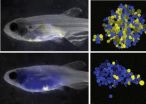(Press-News.org) E-cigarettes, promoted as a way to quit regular cigarettes, may actually be a new route to conventional smoking and nicotine addiction for teenagers, according to a new UC San Francisco study.
In the first analysis of the relationship between e-cigarette use and smoking among adolescents in the United States, UCSF researchers found that adolescents who used the devices were more likely to smoke cigarettes and less likely to quit smoking. The study of nearly 40,000 youth around the country also found that e-cigarette use among middle and high school students doubled between 2011 and 2012, from 3.1 percent to 6.5 percent.
"Despite claims that e-cigarettes are helping people quit smoking, we found that e-cigarettes were associated with more, not less, cigarette smoking among adolescents," said lead author Lauren Dutra, a postdoctoral fellow at the UCSF Center for Tobacco Control Research and Education.
"E-cigarettes are likely to be gateway devices for nicotine addiction among youth, opening up a whole new market for tobacco," she said.
The study will be published online on March 6 in JAMA Pediatrics.
E-cigarettes are battery-powered devices that look like cigarettes and deliver an aerosol of nicotine and other chemicals. Promoted as safer alternatives to cigarettes and smoking cessation aids, the devices are rapidly gaining popularity among adults and youth in the U.S. and around the world. Unregulated by the U.S. Food and Drug Administration, e-cigarettes have been widely promoted by their manufacturers as a way for people to quit smoking conventional cigarettes. They are sold in flavors such as chocolate and strawberry that are banned in conventional cigarettes because of their appeal to youth.
In the new UCSF study, the researchers examined survey data from middle and high school students who completed the National Youth Tobacco Survey in 2011 and 2012.
The authors found that the devices were associated with higher odds of progression from experimenting with cigarettes to becoming established cigarette smokers. Additionally, adolescents who smoked both conventional cigarettes and e-cigarettes smoked more cigarettes per day than non-e-cigarette users.
Contrary to advertiser claims that e-cigarettes can help consumers stop smoking conventional cigarettes, teenagers who used e-cigarettes and conventional cigarettes were much less likely to have abstained from cigarettes in the past 30 days, 6 months, or year. At the same time, they were more likely to be planning to quit smoking in the next year than smokers who did not use e-cigarettes.
The study's cross-sectional nature didn't allow the researchers to identify whether most youths initiated with conventional cigarettes or e-cigarettes. But the authors noted that about 20 percent of middle school students and about 7 percent of high school students who had ever used e-cigarettes had never smoked regular cigarettes – meaning that some kids are introduced to the addictive drug nicotine through e-cigarettes, the authors said.
"It looks to me like the wild west marketing of e-cigarettes is not only encouraging youth to smoke them, but also it is promoting regular cigarette smoking among youth," said senior author Stanton A. Glantz, PhD, UCSF professor of medicine and director of the Center for Tobacco Control Research and Education.
The new results are consistent with a similar study of 75,000 Korean adolescents published last year by UCSF researchers, which also found that adolescents who used e-cigarettes were less likely to have stopped smoking conventional cigarettes (visit bit.ly/1fFNWbc to learn more).
In combination, the two studies suggest that "e-cigarettes may contribute to nicotine addiction and are unlikely to discourage conventional cigarette smoking among youths," said the scientists.
The federal Centers for Disease Control and Prevention reported last year that the majority of adolescents who have ever smoked e-cigarettes also have smoked regular cigarettes. An estimated 1.78 million U.S. students have used the devices as of 2012, the CDC reported.
INFORMATION:
The research was funded by the National Cancer Institute (grants CA-113710 and CA-060121).
The Center for Tobacco Control Research and Education specializes in tobacco control research focused on policy change, smoking cessation, nicotine addiction, health disparities in smoking, novel tobacco devices and tobacco marketing. It also houses the Legacy Tobacco Documents Library, a rich resource of previously confidential tobacco industry documents.
UCSF is a leading university dedicated to promoting health worldwide through advanced biomedical research, graduate-level education in the life sciences and health professions, and excellence in patient care. It includes top-ranked graduate schools of dentistry, medicine, nursing and pharmacy, a graduate division with nationally renowned programs in basic biomedical, translational and population sciences, as well as a preeminent biomedical research enterprise and two top-ranked hospitals, UCSF Medical Center and UCSF Benioff Children's Hospital.
E-cigarettes: Gateway to nicotine addiction for US teens, says UCSF study
First national analysis strongly associates e-cigarettes with smoking for many adolescents
2014-03-06
ELSE PRESS RELEASES FROM THIS DATE:
Up-converted radio
2014-03-06
Ever worry about losing your mobile-phone reception? The problem is a weak microwave signal. The same problem hampers cosmologists looking at the early universe, a glimpse embodied in the cosmic microwave background. Or take a pressing earthly example: oncologists often locate and identify tumors using MRI scans. All three of these efforts---communications, cosmology, medicine---depend on discriminating weak microwave or radio signals from a noisy environment. A new approach to this important problem provides a clean, all-optical detection of microwaves and radiowaves ...
Discovery sheds new light on marijuana's anxiety relief effects
2014-03-06
An international group led by Vanderbilt University researchers has found cannabinoid receptors, through which marijuana exerts its effects, in a key emotional hub in the brain involved in regulating anxiety and the flight-or-fight response.
This is the first time cannabinoid receptors have been identified in the central nucleus of the amygdala in a mouse model, they report in the current issue of the journal Neuron.
The discovery may help explain why marijuana users say they take the drug mainly to reduce anxiety, said Sachin Patel, M.D., Ph.D., the paper's senior ...
Some people really just don't like music
2014-03-06
It is often said that music is a universal language. However, a new report in the Cell Press journal Current Biology on March 6 finds that music doesn't speak to everyone. There are people who are perfectly able to experience pleasure in other ways who simply don't get music in the way the rest of us do.
The researchers refer to this newly described condition as specific musical anhedonia—in other words, the specific inability to experience pleasure from music.
"The identification of these individuals could be very important to understanding the neural basis of music—that ...
'Seeing' bodies with sound (no sight required)
2014-03-06
People born unable to see are readily capable of learning to perceive the shape of the human body through soundscapes that translate images into sound, according to researchers who report their findings in the Cell Press journal Current Biology on March 6. With a little training, soundscapes representing the outlines and silhouettes of bodies cause the brain's visual cortex—and specifically an area dedicated in normally sighted people to processing body shapes—to light up with activity.
With no more than 70 hours of training on average, study participants could recognize ...
Common mutation is culprit in acute leukemia relapse
2014-03-06
Harvard stem cell scientists have identified a mutation in human cases of acute lymphoblastic leukemia that likely drives relapse. The research, published in Cancer Cell, could translate into improved patient care strategies for this particular blood cancer, which typically affects children but is more deadly in adults.
In recent years, a trend toward single-cell analysis has shown that individual cells within a tumor are capable of amassing mutations to make them more aggressive and treatment resistant. So while 99% of a tumor may be destroyed by the initial treatment, ...
Warming temperatures are pushing 2 chickadee species -- and their hybrids -- northward
2014-03-06
The zone of overlap between two popular, closely related backyard birds is moving northward at a rate that matches warming winter temperatures, according to a study by researchers from the Cornell Lab of Ornithology, Villanova University, and Cornell University. The research will be published online in Current Biology on Thursday, March 6, 2014.
In a narrow strip that runs across the eastern U.S., Carolina Chickadees from the south meet and interbreed with Black-capped Chickadees from the north. The new study finds that this hybrid zone has moved northward at a rate ...
Obese adolescents not getting enough sleep?
2014-03-06
Cincinnati, OH, March 6, 2014 -- Lack of sleep and obesity have been associated with an increased risk of cardiovascular and metabolic diseases in adults and young children. However, the association is not as clear in adolescents, an age group that is known to lack adequate sleep and have an overweight and obesity prevalence rate of 30% in the US. In a new study scheduled for publication in The Journal of Pediatrics, researchers found that cardiometabolic risk in obese adolescents may be predicted by typical sleep patterns.
Heidi B. IglayReger, PhD, and colleagues from ...
Establishing standards where none exist; Harvard researchers define 'good' stem cells
2014-03-06
After more than a decade of incremental – and paradigm shifting, advances in stem cell biology, almost anyone with a basic understanding of life sciences knows that stem cells are the basic form of cell from which all specialized cells, and eventually organs and body parts, derive.
But what makes a "good" stem cell, one that can reliably be used in drug development, and for disease study? Researchers have made enormous strides in understanding the process of cellular reprogramming, and how and why stem cells commit to becoming various types of adult cells. But until now, ...
Dr. Brenna Anderson contributes to expert series on GAS in pregnancy
2014-03-06
Ignaz Semmelweiss made one of the most important contributions to modern medicine when he instituted hand washing in an obstetric clinic in Austria in 1847, decreasing mortality there from more than ten percent to two percent. Unfortunately, infections can still occur in pregnancy and during delivery and can have associated mortality rates of up to 30 to 50 percent if not treated quickly and properly.
Brenna Anderson, MD, director of the Women's Infectious Diseases Consultative Service at Women & Infants of Rhode Island and an associate professor of obstetrics and gynecology ...
Study identifies gene important to breast development and breast cancer
2014-03-06
Significance: Understanding more about how the different types of cells in breast tissue develop improves our knowledge of breast cancer. TAZ represents a potential new target for drug therapies to treat aggressive types of breast cancer.
Background: In cancer, normal cells can become unpredictable or aggressive and thus difficult to treat with anti-cancer drugs. This is especially true in breast cancer. By identifying the genes responsible for this change in cells from breast tissue, researchers hope to identify a way to stop or reverse it.
In breast tissue, there ...
LAST 30 PRESS RELEASES:
Longest observation of an active solar region
Why nail-biting, procrastination and other self-sabotaging behaviors are rooted in survival instincts
Regional variations in mechanical properties of porcine leptomeninges
Artificial empathy in therapy and healthcare: advancements in interpersonal interaction technologies
Why some brains switch gears more efficiently than others
UVA’s Jundong Li wins ICDM’S 2025 Tao Li Award for data mining, machine learning
UVA’s low-power, high-performance computer power player Mircea Stan earns National Academy of Inventors fellowship
Not playing by the rules: USU researcher explores filamentous algae dynamics in rivers
Do our body clocks influence our risk of dementia?
Anthropologists offer new evidence of bipedalism in long-debated fossil discovery
Safer receipt paper from wood
Dosage-sensitive genes suggest no whole-genome duplications in ancestral angiosperm
First ancient human herpesvirus genomes document their deep history with humans
Why Some Bacteria Survive Antibiotics and How to Stop Them - New study reveals that bacteria can survive antibiotic treatment through two fundamentally different “shutdown modes”
UCLA study links scar healing to dangerous placenta condition
CHANGE-seq-BE finds off-target changes in the genome from base editors
The Journal of Nuclear Medicine Ahead-of-Print Tip Sheet: January 2, 2026
Delayed or absent first dose of measles, mumps, and rubella vaccination
Trends in US preterm birth rates by household income and race and ethnicity
Study identifies potential biomarker linked to progression and brain inflammation in multiple sclerosis
Many mothers in Norway do not show up for postnatal check-ups
Researchers want to find out why quick clay is so unstable
Superradiant spins show teamwork at the quantum scale
Cleveland Clinic Research links tumor bacteria to immunotherapy resistance in head and neck cancer
First Editorial of 2026: Resisting AI slop
Joint ground- and space-based observations reveal Saturn-mass rogue planet
Inheritable genetic variant offers protection against blood cancer risk and progression
Pigs settled Pacific islands alongside early human voyagers
A Coral reef’s daily pulse reshapes microbes in surrounding waters
EAST Tokamak experiments exceed plasma density limit, offering new approach to fusion ignition
[Press-News.org] E-cigarettes: Gateway to nicotine addiction for US teens, says UCSF studyFirst national analysis strongly associates e-cigarettes with smoking for many adolescents



